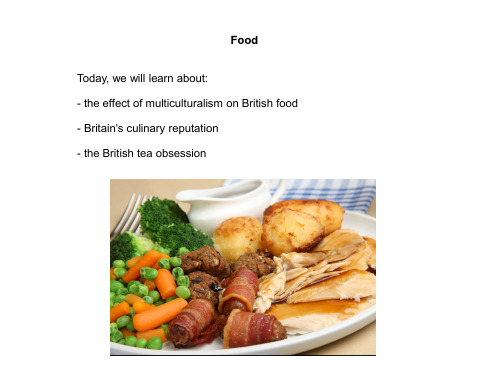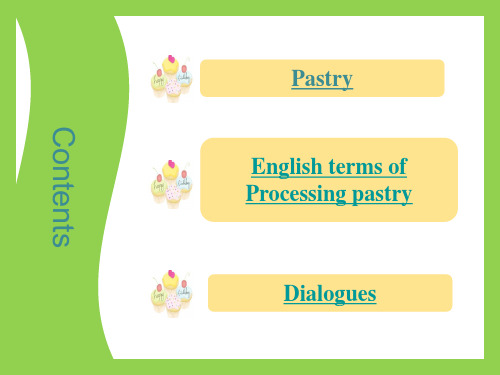食品专业英语课件lesson 12
食品专业英语课件

Part 2 食品科技英语的阅读
Lesson 1 WHO Strategy on Food Safety
Summary WHO has been actively participating in the
development of principles and recommendations for the safety assessment of GM foods derived from genetically modified organisms(GMO). The results developed in the course of various expert consultations from the basis for guidelines on national levels and are presently being incorporated into internationally recognized standards. 对于由转基因生物生产的食品转基因食品,WHO一直以来积 极致力于制订其安全评价的原则和建议。不同专家基于本 译文 国的技术水平而商讨的结果是各国制定标准的指导性依据, 而且这些结论正逐渐成为公认的权威标准。
3. What can you learn from Paragraph 3 ?
A. Most developing countries are not willing to be responsible for the consequence of using the new technology. B. Most developing countries are willing to be responsible for the consequence of using the new technology. C. Most developed countries are not willing to be responsible for the consequence of using the new technology. D. Most developed countries are willing to be responsible for the consequence of using the new technology.
《食品专业英语》课件

要点一
要点二
Importance
Food Professional English is essential for food professionals to expand their knowledge, improve their skills, and enhance their competitiveness in the global market It is also critical for promoting international cooperation and exchange in the food industry
Enhancing vocabulary
Reading news articles can help students expand their vocabulary and learn new words and phrases that are specific to the field of food
Summary
Understand professional vocabulary related to food storage, including refrigeration, freezing, drying, etc.
Detailed description
Food storage is the key to keeping food fresh and safe, so it is necessary to master relevant professional vocabulary. For example, "refrigerator" represents refrigeration, "freeze" represents freezing, and "dry" represents drying. In addition, it is necessary to understand the applicable scope and precautions of different storage methods.
食品专业英语lesson12

Food safety 食品安全New wordscarcin(o)- 癌-gen/-genic/-genous 原,产生carinogen 致癌物质toxic 有毒,中毒logical 逻辑学的toxicological 毒物学的anti- 反,抗,非oxidant 氧化剂antioxidant 抗氧化剂radio- 无线电,辐射,放射nuclide 核素radionuclide 放射性核素intra- 内的,在内的intrastate 州内的fraud 欺骗,欺诈safrole 黄樟油精,黄樟素symphytine 聚合草素preservative 防腐剂cadmium 镉mercury 汞The question,“Is the food safe?”, usually evokes an emotional response. Everybody has a right to a safe and wholesome food supply. 食品是否安全这个问题常常会引起人情绪化的反应。
每一个人都有权获得安全、健康的食品。
Yet the question of food safety is a complicated one. 然而食品安全问题是一个复杂的问题。
The concept of food safety has many facets. Perhaps the most obvious, and certainly the most prevalent problem of food safety is microbiological food poisoning. 食品安全有许多方面,也许食品安全中最明显的,最普遍的问题是食品的微生物毒害。
This is serious problem in nearly every country, but another aspect of food safety is primarily concerned with chemicals. 这是几乎在每一个国家都很严重的问题,但是食品安全的另一个主要关注的方面主要与化学药品有关。
《食品专业英语》课件

食品相关的英语单词、短语和表达
食材、菜谱、制作方法的英语表述 餐饮服务中的英语用语 食品广告和营销中的英语词汇
学习如何用英语描述食材、菜谱和不同的 制作方法,拓展你的英语词汇。
掌握在餐馆和酒店工作时常用的英语用语, 与国际客人交流更加流利和自信。
3
食品生产、加工和销售中遵循的规定
了解食品生产、加工和销售中需要遵循的规定,以确保食品的合规性和质量。
总结
1 回顾本课程的学
习内容
总结本课程中学到的 关键知识和技能,强 化学习成果。
2 总结食品学、英
语和行业术语的
3 推荐相关书籍、
网站和课程
关系
探讨食品学、英语语
分享教材和资源推荐,
言能力和行业术语之
《食品专业英语》PPT课 件
欢迎来到《食品专业英语》课程!在本课程中,我们将探索食品学的基础知 识、食品相关的英语单词和表达,以及食品行业的常用术语和标准。
课程介绍
食品学的基础知识
了解食品分类、特性以及食品加工和保存等基础知识。
食品相关的英语单词、短语和表达
学习食材、菜谱以及餐饮服务中的英语用语。
帮助学生进一步拓展
间的联系,帮助学生
知识和提升技能。
更好地掌握专业知识。
了解食品广告和营销领域中常用的英语词 汇,为将来的职业发展做好准备。
食品行业的常用术语和标准
1
食品质量管理的标准和规定
了解食品质量管理中的标准和规定,如ISO 22000和HACCP等,确保食品的安全和 质量。
2
食品安全的常用术语和法规
掌握食品安全领域中常用的术语和法规,如食品安全法和食品添加剂的使用规定。
12. Food lesson PPT

1942 – almost all except bread and vegetables
Public catering
Restaurants were initially exempt from rationing, but this was resented, as people with more money could supplement their food rations by eating out frequently. The Ministry of Food in May 1942 issued new restrictions on restaurants: - Meals were limited to 3 courses; only one component dish could contain fish or game or poultry (but not more than one of these) - In general no meals could be served between 11 p.m. (midnight in London) and 5 a.m. without a special license
The National Loaf 'wholegrain'
Lasting impact - “finish your plate!” - Rationing continued until 1954 because of economical pressures - A whole generation raised on importance of high energy bulk food, rather than taste or appearance - Stereotype TASK Write 6-8 lines, explaining the effect of war on British cuisine, and how this led to the stereotype that 'British food is terrible'
食品专业英语课件

Special example:
通讯作者署名之后常加注“*”,并把与之相关的信息如:电话(Tel)、 传真(Fax)、邮箱号(E-mail address)等置于标题所在页的底部, 作为题注(footnotes)。
(二)摘要(abstract/summary)
摘要是对文章内容准确、扼要的表达,不加解释和评论,使读者对整篇 论文了解梗概,使其判定是否要通读全文。几乎所有公开发表的科技论 文都要有短小简洁的英文摘要,这是食品科技论文的一般要求。不仅英 文论文如此,国内大多数中文科技论文也要求提供英文摘要。
Example 22:
Example 23:
Example 24:
二、修辞特点
科技英语的逻辑性、严密性、简明性较普通英语更突出。
用词方面: 专业术语较多,一词一意,词义专业,能够准确的表达科 学含义。 专业术语词形较长,发音较难,但却广泛应用于科技论文 中。 许多词语来源于希腊语和拉丁语,前后缀出现频率较高, 还有大量缩写词,使翻译英文专业科技论文有一定的难度。 多用介词短语、分词短语、形容词短语、动词不定式短语 等,使句子结构简洁而信息容量大。
• 各刊物对标题的字数、大小写都有限制和明确规定。
Instructions to author/Information for authors/Author Guidelines 以及期刊近期的范文
• 题名字母的大小写有以下三种格式。
A. 全部字母大写。For example: DISCUSSION ABOUT THE ENVY OF CHIDREN AND THE AGED。 B. 每个词的首字母大写,但三个或四个字母以下的冠词、连词、介 词,如不在句首,全部小写。 For example: From “Go-back-to-history” to Non-history ---- A Criticism of New Historicism.(Journal of Food Science) C. 题名第一个词的首字母大写,其余字母均小写。 For example: Topographic inversion of interval velocities.
食品专业英语文选(第二版)

电子出版物数据中心中国轻工业出版社出品京新出音[2010]419号ISBN 978-7-89991-109-9高等学校专业教材食品专业英语文选(第二版)许学勤主编目录•Lesson 1 Food Industry •Lesson 2 Water•Lesson 3 Carbohydrates •Lesson 4 Proteins•Lesson 5 Lipids•Lesson 6 Vitamins and Minerals •Lesson 7 Food Additive •Lesson 8 Food Microbiology •Lesson 9 Fermentation Glossary Glossary Glossary Glossary Glossary Glossary Glossary Glossary Glossary•Lesson 10 Physical Properties of Foods•Lesson 11 Food Dispersions•Lesson 12 Food Preservation•Lesson 13 Food Processing•Lesson 14 Unit Operations in Food Processing •Lesson 15 Food Packaging•Lesson 16 Thermal Treatment and Thermal Processing •Lesson 17 Food Concentration•Lesson 18 Food Dehydration and Drying Glossary Glossary Glossary Glossary Glossary Glossary Glossary Glossary Glossary•Lesson 19 Food Freezing•Lesson 20 Extrusion Cooking•Lesson 21 Membrane Separation•Lesson 22 Meat and Meat Products•Lesson 23 Milk and Milk Products•Lesson 24 Poultry and Eggs•Lesson 25 Principles of Baking•Lesson 26 Confectionery and Chocolate Products •Lesson 27 Fruit Juices Glossary Glossary Glossary Glossary Glossary Glossary Glossary Glossary Glossary•Lesson 28 Beverages•Lesson 29 Food Safety•Lesson 30 Hazard Analysis and Critical Control Points •Lesson 31 Good Manufacturing Practice (GMP)•Lesson 32 Sanitation in Food Plant•Lesson 33 Food Quality•Lesson 34 Shelf-life of Food Products Glossary Glossary Glossary Glossary Glossary Glossary Glossary。
食品专业英语文选(第二版)

电子出版物数据中心中国轻工业出版社出品京新出音[2010]419号ISBN 978-7-89991-109-9高等学校专业教材食品专业英语文选(第二版)许学勤主编目录•Lesson 1 Food Industry •Lesson 2 Water•Lesson 3 Carbohydrates •Lesson 4 Proteins•Lesson 5 Lipids•Lesson 6 Vitamins and Minerals •Lesson 7 Food Additive •Lesson 8 Food Microbiology •Lesson 9 Fermentation Glossary Glossary Glossary Glossary Glossary Glossary Glossary Glossary Glossary•Lesson 10 Physical Properties of Foods•Lesson 11 Food Dispersions•Lesson 12 Food Preservation•Lesson 13 Food Processing•Lesson 14 Unit Operations in Food Processing •Lesson 15 Food Packaging•Lesson 16 Thermal Treatment and Thermal Processing •Lesson 17 Food Concentration•Lesson 18 Food Dehydration and Drying Glossary Glossary Glossary Glossary Glossary Glossary Glossary Glossary Glossary•Lesson 19 Food Freezing•Lesson 20 Extrusion Cooking•Lesson 21 Membrane Separation•Lesson 22 Meat and Meat Products•Lesson 23 Milk and Milk Products•Lesson 24 Poultry and Eggs•Lesson 25 Principles of Baking•Lesson 26 Confectionery and Chocolate Products •Lesson 27 Fruit Juices Glossary Glossary Glossary Glossary Glossary Glossary Glossary Glossary Glossary•Lesson 28 Beverages•Lesson 29 Food Safety•Lesson 30 Hazard Analysis and Critical Control Points •Lesson 31 Good Manufacturing Practice (GMP)•Lesson 32 Sanitation in Food Plant•Lesson 33 Food Quality•Lesson 34 Shelf-life of Food Products Glossary Glossary Glossary Glossary Glossary Glossary Glossary。
烹饪厨房英语unit12pastry课件

milk pudding
பைடு நூலகம்ream
fruit pudding
raisin pudding
Mousse
chocolate mousse green tea mousse
Mousse
cream mousse
fruit mousse
English terms of processing pastry
Dialogue 2:
Dialogues
Waiter: Would you like to choose a birthday cake? Guest: Yes. It’s my son’s birthday. I would like to order a birthday cake. Waiter: What kind of cake would you like?Would you prefer an almond cake or a chocolate cake? Guest: A chocolate cake. Waiter: What would you like written on the cake? Guest: Let’s see…Happy birthday, David! That’s all.
knead the dough fold the dough shape the dough flatten the dough
揉面团 折叠面团 将面团塑形 擀平面团
English terms of processing pastry
mix the ingredients braid the dough wrap the dough tightly
Dialogues
Waiter: How many candles would you like on the cake? Guest: Eight . Waiter: How many servings of the chocolate cake do you need? Guest:Six. Waiter: When do you want the cake? Guest: At noon tomorrow. Please send the cake up to Room 1608 at exactly 12:30 tomorrow.Thank you very much. Waiter: My pleasure.
食品专业英语lesson12

Food safety 食品安全New wordscarcin(o)- 癌-gen/-genic/-genous 原,产生carinogen 致癌物质toxic 有毒,中毒logical 逻辑学的toxicological 毒物学的anti- 反,抗,非oxidant 氧化剂antioxidant 抗氧化剂radio- 无线电,辐射,放射nuclide 核素radionuclide 放射性核素intra- 内的,在内的intrastate 州内的fraud 欺骗,欺诈safrole 黄樟油精,黄樟素symphytine 聚合草素preservative 防腐剂cadmium 镉mercury 汞The question,“Is the food safe?”, usually evokes an emotional response. Everybody has a right to a safe and wholesome food supply. 食品是否安全这个问题常常会引起人情绪化的反应。
每一个人都有权获得安全、健康的食品。
Yet the question of food safety is a complicated one. 然而食品安全问题是一个复杂的问题。
The concept of food safety has many facets. Perhaps the most obvious, and certainly the most prevalent problem of food safety is microbiological food poisoning. 食品安全有许多方面,也许食品安全中最明显的,最普遍的问题是食品的微生物毒害。
This is serious problem in nearly every country, but another aspect of food safety is primarily concerned with chemicals. 这是几乎在每一个国家都很严重的问题,但是食品安全的另一个主要关注的方面主要与化学药品有关。
- 1、下载文档前请自行甄别文档内容的完整性,平台不提供额外的编辑、内容补充、找答案等附加服务。
- 2、"仅部分预览"的文档,不可在线预览部分如存在完整性等问题,可反馈申请退款(可完整预览的文档不适用该条件!)。
- 3、如文档侵犯您的权益,请联系客服反馈,我们会尽快为您处理(人工客服工作时间:9:00-18:30)。
Lesson 12 Food Safety一、Six food safety issues1.The label of foods are not normative. 包装类食品标签不规范2、Food additives do not meet the standard requirements. 食品添加剂不符合标准规定3、Some of the ingredients in foods do not meet requirements . 一些食品的成分含量不符合要求4、Water injection meat still exists. 注水肉现象依然存在5、Aquatic products fairly serious heavy metal over-standard.水产品重金属超标问题比较严重。
6、Some food health indicators failure. 一些食品的卫生不符合要求。
二、texttox- or toxi-or toxo- poison 毒素toxin : 毒素toxenzyme 毒酶toxoid 变性毒素toxic- or toxico- 毒物toxicology 毒理学toxicant 毒药,有毒的carcin- or carcino- : tumor; 癌的carcinogen 致癌物质carcinoid 良性肿瘤have a [no] right to (sth.) 有[没有]要求(某事物)的权利。
subject oneself to 蒙,受。
safrole n. [化学] 黄樟素flavoring agent增香剂,香味料。
flavoring n. 调味品,佐料。
cereal grains 粮谷,谷粒etc. et cetera, and others especially of the same kind.In terms of 在……方面lettuce n. 莴苣lead 铅EpidemiologyFoodborne diseases each year in USAffects 1 in 4 Americans76 million illnesses325,000 hospitalizations5,000 deaths1,500 of those deaths caused by Salmonella, Listeria, and Toxoplasma三、Biological Hazards in FoodBiological = Living Organisms•In Meat and Poultry:•Salmonella bacteria (poultry and eggs)•Trichinella spiralis parasite (pork)•On Fruits and Vegetables:• E. coli bacteria (apple juice)•Cyclospora parasite (raspberries)•Hepatitis A virus (strawberries)How can you prevent Biological Hazard to FoodsPrevention of microbes growingHolding at low temperaturesCooling quicklyCooking helps to kill microbes>165oF(73o C) for poultry and eggs>155oF (68o C) for ground beef>160oF (71o C) for porkCampylobacteriosisSources•Raw or undercooked poultry•Non-chlorinated water•Raw milk•Infected animal or human feces•Poultry, cattle, puppies, kittens, pet birds Clinical signs•Diarrhea, abdominal cramps,fever, nausea•Duration: 2-5 daysSalmonellosis•Gram negative bacteria•Many serotypes can cause disease•S.enteritidis and typhimurium•41% of all human cases•Most common species in U.S.• 1.4 million cases annually•580 deathsSalmonellosis•Sources•Raw poultry and eggs•Raw milk•Raw beef•Unwashed fruit, alfalfa sprouts•Reptile pets: Snakes, turtles, lizards•Signs•Onset: 12-72 hours•Diarrhea, fever, cramps•Duration: 4-7 daysE. coli O157:H7•Enterohemorrhagic Escherichia coli (EHEC) •Surface proteins; toxin•Sources•Undercooked or raw hamburger; salami•Alfalfa sprouts; lettuce•Unpasteurized milk, apple juice or cider•Well water•Animals: Cattle, other mammals•Signs•Watery or bloody diarrhea, nausea, cramps•Onset: 2-5 days•Duration: 5-10 days•Sequela•Hemolytic Uremic Syndrome (HUS)•Acute kidney failure in children•Life threateningOrganisms•Norwalk-like viruses•Campylobacter•Salmonella• E. coli O157:H7•Clostridium botulinum•Shigella spp•Toxoplasma•Emerging organismsNorwalk-like Viruses•Norovirus; Caliciviridae family•Most common foodborne agent•23 million cases annually•Sources•Person-to-person•Shed in human feces, vomitus•Outbreaks in daycares, nursing homes, cruise ships•Contaminated shellfish四、Chemical Hazards in FoodChemical hazard: a toxic substance that is produced naturally added intentionally or un-intentionally•Naturally-occurring:•Natural toxins (aflatoxins, marine toxins)•Added intentionally:•Antibiotics, preservatives•Added non-intentionally:•Cleaning agents, Pesticide Residues五、Physical Hazards in FoodPhysical hazard: a hard foreign object that can cause illness or injury•Inherent to the food or ingredient•Bone fragment, feathers•Contaminant during processing•Stones, rocks, dirt, fingernails六、Prevention and Control1. HACCP•Hazard Analysis Critical Control Point•To monitor and control production processes•Identify food safety hazards and critical control points•Production, processing and marketing•Establish limits•Monitor•Applied to meat, poultry, and eggs2.On Farm Strategies•Testing and removal for Salmonella•Serologic, fecal culture, hide culture •Vaccinating•Many serotypes•Varying effectiveness•Minimize rodents, wild birds•Isolation of new animals3.At the Slaughter Plant•FSIS target organisms•Salmonella and E. coli•Control points•Removal of internal organs•Minimize contact between carcasses•Proper movement through facilities•Chilling•Cooking processes (time, temperature)4. Irradiation•Used since 1986 for Trichina control in pork•Gamma rays•Poultry in 1990/1992•Meat in 1997/1999•Reduction of bacterial pathogens•Kills living cells of organisms•Damaged and cannot survive•Identified with radura…..•Does not affect taste quality•Nutrients remain the same•Handle foods appropriately afterwards•Does not sterilize•Contamination can still occur5.At Home•Drink pasteurized milk and juices•Wash hands carefully and frequently•After using the bathroom•Changing infant’s diapers•Cleaning up animal feces•Wash hands before preparing food•Wash raw fruits and vegetables before eating •After contact with raw meat or poultry•Wash hands, utensils and kitchen surfaces•Hot soapy water•Defrost meats in the refrigerator•Cook beef/beef products thoroughly •Internal temperature of 160oF•Cook poultry and eggs thoroughly •Internal temperature of 170-180oF•Eat cooked food promptly•Refrigerate leftovers within 2 hours after cooking •Store in shallow containers。
